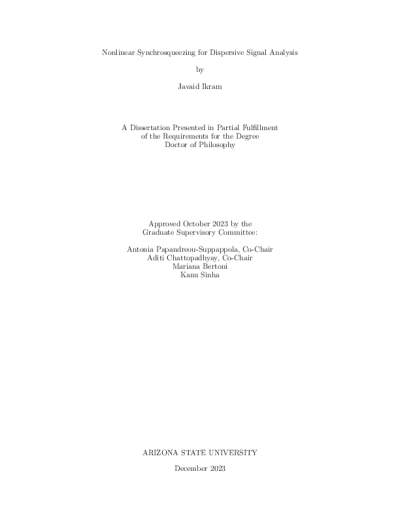Nonlinear Synchrosqueezing for Dispersive Signal Analysis

Description
The propagation of waves in solids, especially when characterized by dispersion, remains a topic of profound interest in the field of signal processing. Dispersion represents a phenomenon where wave speed becomes a function of frequency and results in multiple oscillatory modes. Such signals find application in structural healthmonitoring for identifying potential damage sensitive features in complex materials.
Consequently, it becomes important to find matched time-frequency representations
for characterizing the properties of the multiple frequency-dependent modes of propagation in dispersive material. Various time-frequency representations have been
used for dispersive signal analysis. However, some of them suffered from poor timefrequency localization or were designed to match only specific dispersion modes with
known characteristics, or could not reconstruct individual dispersive modes. This
thesis proposes a new time-frequency representation, the nonlinear synchrosqueezing
transform (NSST) that is designed to offer high localization to signals with nonlinear time-frequency group delay signatures. The NSST follows the technique used
by reassignment and synchrosqueezing methods to reassign time-frequency points of
the short-time Fourier transform and wavelet transform to specific localized regions
in the time-frequency plane. As the NSST is designed to match signals with third
order polynomial phase functions in the frequency domain, we derive matched group
delay estimators for the time-frequency point reassignment. This leads to a highly localized representation for nonlinear time-frequency characteristics that also allow for
the reconstruction of individual dispersive modes from multicomponent signals. For
the reconstruction process, we propose a novel unsupervised learning approach that
does not require prior information on the variation or number of modes in the signal.
We also propose a Bayesian group delay mode merging approach for reconstructing
modes that overlap in time and frequency. In addition to using simulated signals, we demonstrate the performance of the new NSST, together with mode extraction, using
real experimental data of ultrasonic guided waves propagating through a composite
plate.
Date Created
The date the item was original created (prior to any relationship with the ASU Digital Repositories.)
2023
Agent
- Author (aut): Ikram, Javaid
- Thesis advisor (ths): Papandreou-Suppappola, Antonia
- Thesis advisor (ths): Chattopadhyay, Aditi
- Committee member: Bertoni, Mariana
- Committee member: Sinha, Kanu
- Publisher (pbl): Arizona State University
